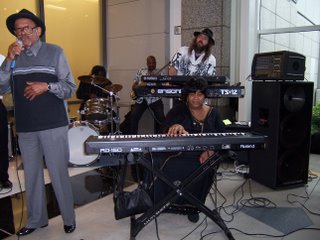Blues Masters Opens May 18

Beverly Stoval seemed to walk off the canvas...Gayles' portrait of her one of my favorites: seated at the piano, her hands sitting just at the top of the keyboard as if she were playing, the music scoring the silence – the actual instrument just below. It was a real treat to see her step out of the frame and join the Bay Area Blues Society Caravan of All-Stars at the Blues Masters opening reception -- one woman who could hold her own.
It certainly felt like a man's world that evening, but Gayles' work certainly celebrated the creative feminine, his body of work featuring many besides Stoval: Big Mama Thorton, Sugar Pie DeSanto, and others.
Blues Masters will travel to Old Oakland when it leaves downtown, but you don't want to miss the marvelous series of paintings in their present setting. The curator did a wonderful job at The Craft & Cultural Arts Gallery. The exhibit is up through June 28, at 1515 Clay Street, Oakland, (510) 622-8190. Visit CCAGallery@mail2Art.com. Admission is free.
More Blues
The Hayward/Russell City Blues Festival: The Gents & Ladies of Russell City, July 8-9, 11:00 a.m. to 7:00 p.m., 777 "B" Street, Hayward City Hall Plaza. Ticket prices are $15 in advance, $20 at the gate. Two day tickets are $26 in advance, students and seniors (62+) are $10. Groups rates of 10 or more are $10 each. For those under 12 years old admission is free.
Forward to Exhibition Catalog
"Blues could not exist if the African captives had not become American captives." Amiri Baraka states in Blues People. The blues was the Black community's measurement of its reality – a yardstick which did not lie. James Gayles’ "Blues Masters" is a notch in that stick, 27 pieces of art, 20 included in this catalog evidence that such a tradition exists. Fluent in the liquid colors spoken so articulately, Gayles’ canvasses are witness to the shared artistry: a visual and musical union.
Etta James, Johnny Lee Hooker, Sugar Pie DeSanto, Jimmy McCracklin, Big Mama Thornton, Etta James… the men and women portrayed in the exhibition loved to sing and perform – it was their daily bread, warm butter and steamy milk.
"I have a deep and tremendous respect for the Blues and its place in the musical landscape of the world." Gayles said. "This tradition was carried by the slaves into the new world and transformed into field hollers and calls sang by the slaves while working on plantations.
"The story of the Blues is a story of how a downtrodden people in the face of oppression rose up and triumphed through their music." Gayles continues.
If one can imagine the life of the enslaved Africans in this strange land – among even stranger people, it is amazing how this creative outlet is not only still here, it is everywhere else conceivable in the world now, much too often credited to someone else.
If we were in Africa, let’s say Senegal or Mali maybe Congo or Sudan, families groomed as historians would sing their communities’ praises, extolling the virtues of their leaders. Such djalis or griots made encyclopedias unnecessary, as the history of nations was imprinted on their collective hearts.
So it is with these 20 blues artists in this show. Many of them performed because their sanity was wrapped in the chords, seated alongside notes on the sheets, the words slipping off their tongues into the night... a forgiving night just before a breaking day.
The blues is the story of the rough and tumble lives African slaves met when freedom rang and no one heard the bell chiming or if they did, they certainly didn’t care enough to push this government to fess up and pay the enslaved Africans back wages.
It was a lonely time then, and blues singers captured that isolation, fear and desperation– a desperation relieved when someone picked up a jug, a harmonica, a tambourine or just clapped. Indigo is not the color of sorrow. It is actually the color of hope, the color of oceans -- Mama Yemeya, the color of taking stock, measuring one's steps and starting out anew.
After the bustle of day, Black people often looked forward to the evening when they could gather and listen to a blues artist sing them into a better place the same way Negro Spirituals transported the holy to glory come Sunday.
Black Americans are blues people… it’s in the water, the DNA… the way we walk, the ideas we claim and even those we dismiss. Blues is something unique to Black people. Others may make all the money, try to cheat an innogaddingike Bob Geddins, the father of West Coast Blues of his fame— even put a white man’s face on Big Mama Thornton’s hit single: "Hound Dog," but there’s one thing about being original… it needs no explaining.
Wanda Sabir
Arts Editor, San Francisco Bay View Newspaper,
Professor of English, College of Alameda,
Co-founder and CEO, MAAFA, San Francisco Bay Area


0 Comments:
Post a Comment
<< Home